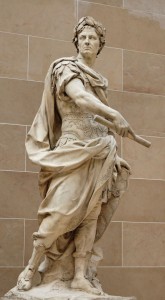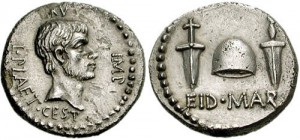Be aware: Coins with ties to the Ides of March!
 “Beware the Ides of March…” The Soothsayer’s warning to Julius Caesar in Shakepeare’s play is familiar to many. But how many actually know where it hails from? And furthermore: why do we call March 15 the “Ides of March?” The Bard’s work was written more than 1600 years after the events that inspired it.
“Beware the Ides of March…” The Soothsayer’s warning to Julius Caesar in Shakepeare’s play is familiar to many. But how many actually know where it hails from? And furthermore: why do we call March 15 the “Ides of March?” The Bard’s work was written more than 1600 years after the events that inspired it.
In ancient Rome, the calendar looked nothing like what we use today. Time was charted more closely to the lunar phases, with each month following three main phases: Kalends (Kal), Nones (Non) and Ides (Id). The full moon marked the Ides, falling on either the 13th or 15th of the month. And before the switch to the Julian calendar, March 15th marked the first full moon of a new year.
It was in 46 B.C. that Caesar replaced the traditional Roman calendar with the updated Julian version, moving the start of the new year to January 1. He was named dictator for life (Dictator Perpetuus) not long after that and became the first Roman emperor to place his own image on coinage. As the senate grew increasingly wary of Caesar’s growing power, they began plotting his downfall…
 Although many records say that Caesar’s murder plot was executed in the Senate House, it actually transpired in an annex of the Theater of Pompey. On March 15, 44 B.C., (the Ides of March) approximately 60 senators cornered the Roman emperor near a statue of Pompey the Great and stabbed him 23 times. That group of men included Brutus and Cassius – two of Caesar’s most trusted government officials.
Although many records say that Caesar’s murder plot was executed in the Senate House, it actually transpired in an annex of the Theater of Pompey. On March 15, 44 B.C., (the Ides of March) approximately 60 senators cornered the Roman emperor near a statue of Pompey the Great and stabbed him 23 times. That group of men included Brutus and Cassius – two of Caesar’s most trusted government officials.
Coins: marking history for centuries
Back then, coins were one of the main ways leaders had to communicate with the masses. So it’s no surprise that a coin commemorating the assassination was issued by Marcus Brutus soon after the attack. Known as the “Eid Mar” coin, this silver denarius is a beloved collectible – and is named #1 in the Whitman book 100 Greatest Ancient Coins. Brutus’ profile appears on the obverse, while the reverse shows a Liberty cap between two daggers (representing Caesar’s stabbing), along with the inscription eid • mar. Many of these pieces were melted down not long after they were struck, making them scarce and hard to own for today’s collectors.

There are definitely more affordable collecting options for those who enjoy the history behind this “Ides of March” tale. While a coin bearing the portrait of Julius Caesar would be an outstanding addition to any collection, it can still be a bit pricey. In the “far more affordable” corner, you can own a silver denarius struck around the time of Caesar’s rule.
Today, the phrase “beware the Ides of March” is used by many who think of nothing more than a Shakespearean play. In reality, it holds a vein of history that runs deep!




Thank you for sharing amazing blog. It’s really very informative…..
We’re glad you liked it. Happy Collecting!